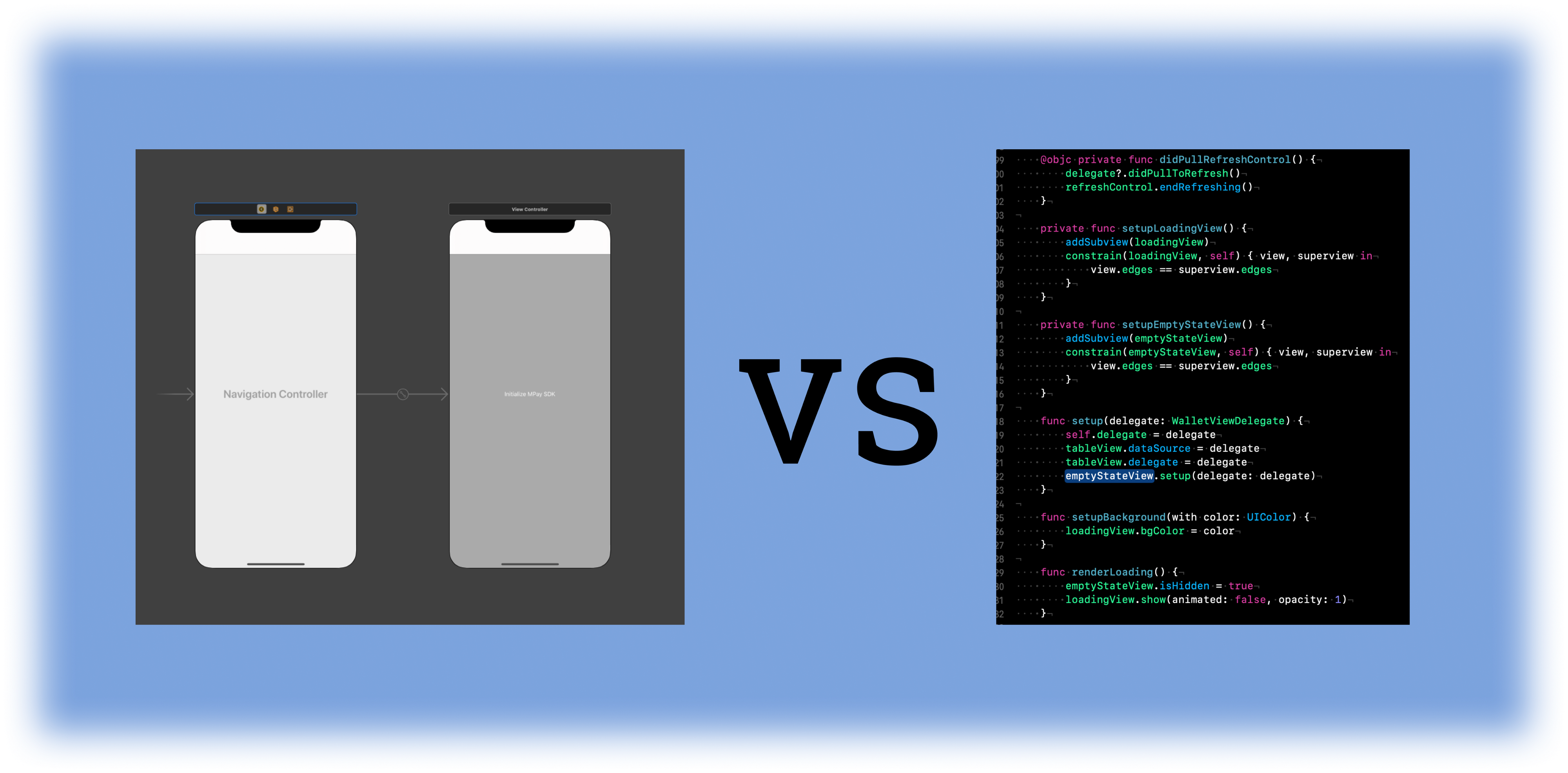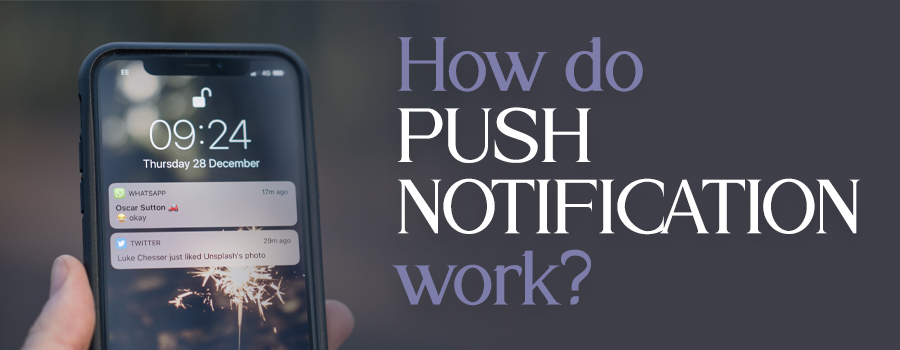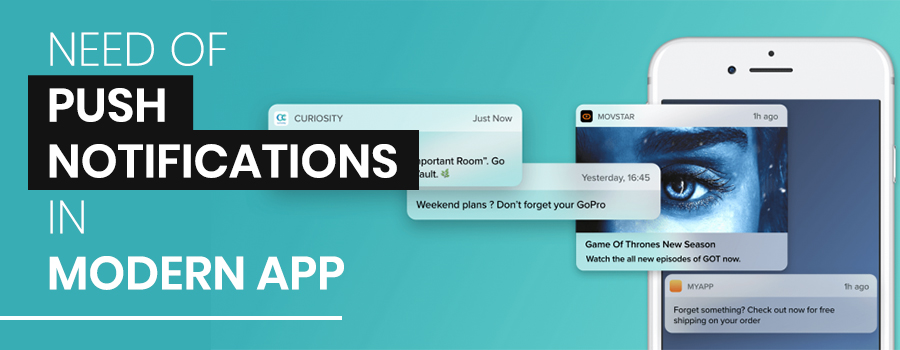
Storyboard v/s SwiftUI
13th March 2021
Web Responsive Tips
22nd March 2021Push Notifications can be understood as a message that is “pushed” from backend Apps or server to UI (user interface), e.g. mobile applications and desktop applications.
What are the Push Notifications?
- A push notification is actually a message that pops up on a cell phone, desktops and laptops
- App advertisers can send push notifications’ or ‘web service Push notification’ at any time, and clients do not need to be utilizing their devices to get them.
- Push notification can do a great deal of things; for instance, they can demonstrate the most recent games scores, get a client to make a desired action, for example, downloading a coupon, or update a client about an event, for example, a flash sale.
According to Wikipedia-
“A common scenario of push notification is the client application pops up a message in front of application’s user information, along with the alert sounds. The notification could also be coupled with images and hypertext link in some cases. Via interacting with the push notification it usually brings up the client applications to the front”

Push Notifications
Push notifications look like SMS instant messages and mobile alerts; however, they just target clients who have installed your application. Every mobile platform offers support to push notifications — iOS, Fire OS, Android, Windows and BlackBerry all have their own peculiarities.
Why Website Push Notifications are utilized
Web Push Notifiactions
For instance, a web-based business organization can utilize push notification web service for-
- Sports scores and related updates on their lock screen
- Utility messages like climate, traffic and other important reports
- Complementary Communication Channels like flight status, change, and other related information
- Transactional notices
- Gathering client input
- Re-connecting with inactive clients
- Sales and Promotions (e.g. Announcing limited time sales, driving clients to the application to convert)
- Price drop notifications (e.g. sending alerts to clients who are keeping an eye on price fluctuations on particular items and services)
- Notifying clients when applicable new items are accessible on the application
- New coupons
- Reminding clients about pending items in their shopping baskets
- ‘Product back in stock’ notifications, etc.
For publishers, website push notificationsare an approach to talk specifically to a client. Web push notifications do not get caught in spam channels or overlooked in an inbox, and their CTRs can be twice as high as email. They can likewise remind clients to utilize an application, regardless of whether the application is open or not. They can likewise be utilized to drive activities, for example,
- Promoting items or offers to build deals
- Improving client experience
- Converting potential customers to loyal customers
- Sending value-based receipts immediately
- Driving clients to other advertising channels, for example, social media networks
What are Push Notifications on Android and iOS?
- Push notices are straightforward messages conveyed from applications installed on a device.
- Push notifications are broadly utilized on every single cell phone to share updated information or events.
- On Android devices, when you get push notifications, the sender application’s symbol and a message show up in the status bar. At the point when the client taps the notification, he/she arrives on the application.
- Push notification mobile webcan be communicated to all clients (case for marking efforts) or can likewise be sent to only a sub-set of clients, to share customized data.
- On iOS, Apple includes a Notification Center, which is arranged in sequential order, and clients get to the Notification Center by swiping down from the top-point of the screen. Android gadgets indicate new messages on the lock screen.
- iOS gives clients a chance to alter push notification web service at an individual application level. Clients can turn sounds on or off, and pick the style that iOS uses to demonstrate a notification.
- Clients can likewise control the red “Badge” demonstrating the quantity of new notification on an application’s home-screen symbol.
- Android utilizes a standard banner approach that clients can’t change at an OS level.
What is the History of Push Notifications?
- 2003: Blackberry Push Email

Blackberry web Push Email
At that point, in the event that you needed to read your mails while on a train, you required a Blackberry.
RIM was the main OS to utilize Push Notifications for their email application. Afterward, the utilization of Push extended to free messaging between Blackberry gadgets.
- 2009: Apple propelled Apple Push Notification Service (APN)
It was the main and the very first Push Notification Service.
- 2010: Google introduced its own Service
Google Cloud to Device Messaging (C2DM).
- 2012: GCM
Google Cloud Messaging
- 2013: Android 4.2 ICS introduced with Rich Push
Rich Push Notifications contain pictures, and additionally, activity buttons that let clients make prompt activity from a Web Service Push Notification. For instance, the client can play a melody, open the application, or see more data.
- 2014: Apple included Interactive Buttons
These buttons enable clients to send a reaction immediately to the application publisher. Soon after, Apple stretched out push notifications to the Apple Watch.
Who can utilize Push Notifications on iPhone and Android?
Any application provider who needs to share significant and important data to clients can utilize Web Service Push Notification. Website push notifications are regularly utilized by-
- Ecommerce applications
- Shopping applications
- Travel applications
- Utility applications
- Gaming applications
- Service applications
- Content applications
- News applications
- Social media applications, etc.
How does Push Notification Web Service function?

To send Push Notifications from your application, you should set up a server first. This server sends a notification to Apple’s Push Notification Service (APNS) or GCM (Google Cloud Messaging), which at that point sends the notification to the your device.
When a client opens your application, you have a ‘code set-up’ to register their phone/device/gadget on your server. It is a best practice to re-register with the server each time the application is opened to keep any issues when the client gets another device and reestablishes it from a back-up of their old one.
- The client can easily turn off Push Notifications for every application in app settings. On the off chance that they turn-off Notifications in your application or uninstall your application, Apple gives a Feedback benefit which you may use to discover who to quit sending Notifications to.
- The notification delivery is performed through a Push Notification Service, which is particular for every stage: APNS for Apple, MPNS for Windows Phone application, GCM for Android, WNS for Windows Store applications, and so on. In any case, the algorithms for various Push Notification Services are comparable and depend on the following activities:
- The device is enlisted in a Push Notification Service
- The device has descriptor (channel URI, registration Id token) – Type of descriptor relies upon particular kind of Push Notification Service. Then, the descriptor is sent to the server.
- The server sends a notice text to the Push Notification Web Service.
- The Push Notification Service advances the notification content to the device.
Different channels involved in sending Push Notifications
1. OSPNS (Operating System Push Notification Service)-
Every mobile OS, including iOS, Fire OS, Android, Windows, and BlackBerry, has its own service.
2. App Publisher–
The application distributer empowers their application with an OSPNS. At that point, the publisher transfers the application to the application store.
3. Client application
This is an OS-specific application, introduced on a client’s device. It gets incoming notifications.
How to Add Push Notification to an App
- Publisher of the App registers with the OS push notification web service.
- The OS benefit gives an Application Programming Interface (API) to the publisher. The API is a path for the application to speak with the publisher.
- Then publisher adds the SDK to the application. SDK is actually a code library particular to the OS’ Push Notification Web Service.
- Finally, publisher uploads the application to the application store.
How user activation occurs in Push Notifications
- The user visits an OS application store, and then from there, he/she downloads and installs an application.
- In next step, user opens the application. Special identifiers (IDs) for both the application and the device are registered with the OS’ Push Notification Web Service.
- These special identifiers are passed back to the application from the OS push notification service. They are likewise sent to the publisher of app as well.
- Finally, publisher gets and stores these registration elements, including the special identifiers.
How App Publisher sends Push Notifications?
- The publisher forms a manual message through a message composer UI (user interface). Alternatively, on the other hand, the publisher sets up a computerized message to be sent by means of the API.
- The publisher characterizes the audience to whom the push notifications should be sent.
- The publisher decides if the message ought to be sent quickly or should be scheduled.
How do users opt in for Push Notifications?
- iOS applications need a client to allow consent for an application to send those iOS web push notifications but Android and Fire Operating Systems do not ask for such consents for their web service push notification.
- Persuading clients to opt in for push notifications is vital for the accomplishment of iOS. The most part of iOS applications demonstrate a standard iOS alert when the application is opened for the first time.
- A more befitting approach is to demonstrate the value of opting in to clients— for instance, with a personalized welcome series upon the very first open and then letting the client select in later.
- Average rates for iOS web push notifications go from 58% for Philanthropy Applications to 33% for recreations.
- Different high performing applications over all industry verticals have more than 50% opt in rates.
How does web page push notification appear to clients?

- Clients see a push notification as a banner or pop up alert the time they are utilizing their phones. This alert is demonstrated regardless of what the client is doing.
- Most Mobile OS additionally demonstrate Web Service Push Notificationtogether in a single view. For iOSWeb Push Notifications, Apple has a Notification Center. The Notification Center is organized in sequential order, and clients get to the Notification Center by swiping down from the highest point of the screen.
- Android gadgets indicate new messages on the lock screen.
- iOS gives clients a chance to personalize push notifications at an individual application level. Clients can turn sounds on or off, and pick the style that iOS uses to demonstrate push notifications.
- Clients can likewise control the red “badge” demonstrating the quantity of new notices on an application’s home-screen symbol.
- Android utilizes a standard banner approach that clients cannot change at an OS level.
How to use Locations with Push Notifications
- All mobile OS approaches clients for their consent to share their location data.
- iOS shows an opt-in alert to clients and Android offers location opt-in as a feature of the application’s authorization setup amid installation.
- Publishers can convey messages that are more relevant by utilizing location information consolidated with behavioral information.
What is the right Strategy to Use Push Notifications
Push notifications are an immediate way of correspondence with target audiences. Publishers should treat the capacity to correspondence with clients through website Push Notifications as a facility not as a right. They must offer some benefit; on the off chance that they do not; push notifications will be disregarded or killed. A few clients will uninstall the application out and out.
Analytics and estimation are imperative instruments for enhancing your application’s execution. However, it is essential to compose convincing web page push notificationsthat are significant to clients and drive activity. Messaging systems and related strategies in Push Notifications should be measured. Push Notification Strategies, for example, boosting opt-in rates, guaranteeing new clients are appropriately on-boarded, and decreasing Client Churn Rates for your Application are all the keys to an application’s success. Noticeable Push Notifications’ Strategies are-
- Matching up every client’s information across all the channels (web, store, mobile and so forth.) to better comprehend client conduct.
- Making it simple for clients to share content to their social media networks.
- Encouraging clients to opt-in by offering those motivating incentives and instances that highlight the value your push notifications will provide.
Rich media push notifications- iPhone and Android

Presently it is conceivable to insert product images for better engagement and instant connect. It should be possible by integrating with your application’s product feeds. Some fascinating cases of Rich Media Push Notifications are –
- Sending 1-1 dynamic Personalized Rich Media Push Notifications in view of your product category of interest that was not possible with blanket messages.
- Recommending items that attract the clients in view of their past conduct inside your App.
- Embedding item pictures inside the Push Notification straightforwardly from your product feed.
- Sending price drop alerts or accessibility-based triggers based on the client’s advantage.
What is personalized push notifications?
By utilizing behavioral information and client interests, publishers can trigger customized multi-product Push to their audiences through personalized Push notifications. They are normally interactive, scrollable, clickable and when clicked take the client to the relevant product view inside your application.
Does push notifications utilize information?
Applications that utilize push notifications (for example, texting or online networking applications) will use mobile information as well.
What are the Metrics to Track Push Notifications?
- The number of push notifications sent
- Frequency of web service push notification sent
- Push notification mobile web after which the arrangement was disabled
- Open rate and CTR (Click Through Rate)
- The number of web page push notification conveyed
- App dispatch by means of push notification web service
- Time on application after a specific web page push notification
- Number of offers and aggregate sales revenue
- Delivery time for re-engagement
Conclusion
Push notifications can be focused on the particular segments of your client base, and even can be customized for particular application clients. This is a noteworthy advantage when contrasted with SMS text messaging.
Be that as it may, these website push notifications additionally require the management of user identification data along with some sort of interface for composing messages, focusing on them and sending them to ensure guaranteed conversions.
Publishers can manufacture this framework themselves, or they can enlist a vendor to build it for them. Progressively, application distributers/publishers pay for these administrations as opposed to building/manufacturing them, with the goal that they can concentrate on building an extraordinary application. Assembling and keeping up a cross-stage push notification service takes huge assets and continuous upkeep. Web service Push Notification Platform Vendor offers great capacities like-
- Reporting
- Scheduling
- Mobile advertising robotization
- User trait accumulation and segmentation
- Security
- Data administration
- Best Push Notification Tools
- Cross-platform support
On the concluding note, I hope this article would help you know the idiosyncrasies of Push Notifications, and aid you in deciding the most befitting Push Notification Services for you.



